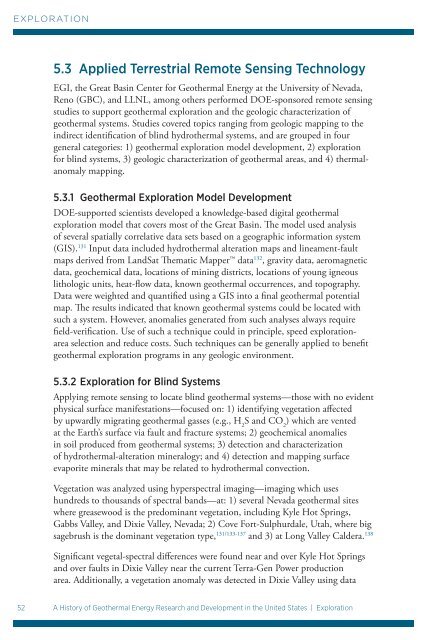A History of Geothermal Energy Research and Development in the ...
A History of Geothermal Energy Research and Development in the ...
A History of Geothermal Energy Research and Development in the ...
Create successful ePaper yourself
Turn your PDF publications into a flip-book with our unique Google optimized e-Paper software.
EXPLORATION<br />
5.3 Applied Terrestrial Remote Sens<strong>in</strong>g Technology<br />
EGI, <strong>the</strong> Great Bas<strong>in</strong> Center for <strong>Geo<strong>the</strong>rmal</strong> <strong>Energy</strong> at <strong>the</strong> University <strong>of</strong> Nevada,<br />
Reno (GBC), <strong>and</strong> LLNL, among o<strong>the</strong>rs performed DOE-sponsored remote sens<strong>in</strong>g<br />
studies to support geo<strong>the</strong>rmal exploration <strong>and</strong> <strong>the</strong> geologic characterization <strong>of</strong><br />
geo<strong>the</strong>rmal systems. Studies covered topics rang<strong>in</strong>g from geologic mapp<strong>in</strong>g to <strong>the</strong><br />
<strong>in</strong>direct identification <strong>of</strong> bl<strong>in</strong>d hydro<strong>the</strong>rmal systems, <strong>and</strong> are grouped <strong>in</strong> four<br />
general categories: 1) geo<strong>the</strong>rmal exploration model development, 2) exploration<br />
for bl<strong>in</strong>d systems, 3) geologic characterization <strong>of</strong> geo<strong>the</strong>rmal areas, <strong>and</strong> 4) <strong>the</strong>rmalanomaly<br />
mapp<strong>in</strong>g.<br />
5.3.1 <strong>Geo<strong>the</strong>rmal</strong> Exploration Model <strong>Development</strong><br />
DOE-supported scientists developed a knowledge-based digital geo<strong>the</strong>rmal<br />
exploration model that covers most <strong>of</strong> <strong>the</strong> Great Bas<strong>in</strong>. The model used analysis<br />
<strong>of</strong> several spatially correlative data sets based on a geographic <strong>in</strong>formation system<br />
(GIS). 131 Input data <strong>in</strong>cluded hydro<strong>the</strong>rmal alteration maps <strong>and</strong> l<strong>in</strong>eament-fault<br />
maps derived from L<strong>and</strong>Sat Thematic Mapper data 132 , gravity data, aeromagnetic<br />
data, geochemical data, locations <strong>of</strong> m<strong>in</strong><strong>in</strong>g districts, locations <strong>of</strong> young igneous<br />
lithologic units, heat-flow data, known geo<strong>the</strong>rmal occurrences, <strong>and</strong> topography.<br />
Data were weighted <strong>and</strong> quantified us<strong>in</strong>g a GIS <strong>in</strong>to a f<strong>in</strong>al geo<strong>the</strong>rmal potential<br />
map. The results <strong>in</strong>dicated that known geo<strong>the</strong>rmal systems could be located with<br />
such a system. However, anomalies generated from such analyses always require<br />
field-verification. Use <strong>of</strong> such a technique could <strong>in</strong> pr<strong>in</strong>ciple, speed explorationarea<br />
selection <strong>and</strong> reduce costs. Such techniques can be generally applied to benefit<br />
geo<strong>the</strong>rmal exploration programs <strong>in</strong> any geologic environment.<br />
5.3.2 Exploration for Bl<strong>in</strong>d Systems<br />
Apply<strong>in</strong>g remote sens<strong>in</strong>g to locate bl<strong>in</strong>d geo<strong>the</strong>rmal systems—those with no evident<br />
physical surface manifestations—focused on: 1) identify<strong>in</strong>g vegetation affected<br />
by upwardly migrat<strong>in</strong>g geo<strong>the</strong>rmal gasses (e.g., H 2<br />
S <strong>and</strong> CO 2<br />
) which are vented<br />
at <strong>the</strong> Earth’s surface via fault <strong>and</strong> fracture systems; 2) geochemical anomalies<br />
<strong>in</strong> soil produced from geo<strong>the</strong>rmal systems; 3) detection <strong>and</strong> characterization<br />
<strong>of</strong> hydro<strong>the</strong>rmal-alteration m<strong>in</strong>eralogy; <strong>and</strong> 4) detection <strong>and</strong> mapp<strong>in</strong>g surface<br />
evaporite m<strong>in</strong>erals that may be related to hydro<strong>the</strong>rmal convection.<br />
Vegetation was analyzed us<strong>in</strong>g hyperspectral imag<strong>in</strong>g—imag<strong>in</strong>g which uses<br />
hundreds to thous<strong>and</strong>s <strong>of</strong> spectral b<strong>and</strong>s—at: 1) several Nevada geo<strong>the</strong>rmal sites<br />
where greasewood is <strong>the</strong> predom<strong>in</strong>ant vegetation, <strong>in</strong>clud<strong>in</strong>g Kyle Hot Spr<strong>in</strong>gs,<br />
Gabbs Valley, <strong>and</strong> Dixie Valley, Nevada; 2) Cove Fort-Sulphurdale, Utah, where big<br />
sagebrush is <strong>the</strong> dom<strong>in</strong>ant vegetation type, 131/133-137 <strong>and</strong> 3) at Long Valley Caldera. 138<br />
Significant vegetal-spectral differences were found near <strong>and</strong> over Kyle Hot Spr<strong>in</strong>gs<br />
<strong>and</strong> over faults <strong>in</strong> Dixie Valley near <strong>the</strong> current Terra-Gen Power production<br />
area. Additionally, a vegetation anomaly was detected <strong>in</strong> Dixie Valley us<strong>in</strong>g data<br />
52 A <strong>History</strong> <strong>of</strong> <strong>Geo<strong>the</strong>rmal</strong> <strong>Energy</strong> <strong>Research</strong> <strong>and</strong> <strong>Development</strong> <strong>in</strong> <strong>the</strong> United States | Exploration

















